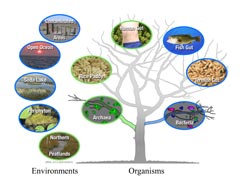Toxic methylmercury-producing microbes more widespread than realized

Newly discovered archaeal (green) and bacterial (blue) organisms that are free-living or within another organism on the tree of life, and their larger environments. <br>
This finding, published in Environmental Science and Technology, explains why deadly methylated mercury is produced in areas where the neurotoxin’s presence has puzzled researchers for decades. Methylmercury — the most dangerous form of mercury — damages the brain and immune system and is especially harmful to developing embryos. Certain bacteria transform inorganic mercury into toxic methylmercury.
The discovery also validates the recent finding that two genes are essential for the methylation of mercury. Previously, only a narrow range of microbes were recognized as mercury methylators, said co-author Dwayne Elias of the Department of Energy laboratory’s Biosciences Division.
“We showed for the first time that many different types of bacteria are able to produce this potent neurotoxin,” Elias said. “The newly identified microbes include methane-producing organisms that live in rice paddies, anaerobic wastewater treatment plants, northern peat lands and possibly within our bodies.”
Elias and colleagues are testing a bacterium from the human intestine that they predict will also methylate mercury. Other bacteria able to transform inorganic into methylmercury include those used in biological dechlorination and metal treatment systems. All of these organisms are anaerobic, which means they grow in habitats without oxygen, including aquatic sediments and wetland soils.
By identifying these organisms, the researchers may have explained why methylmercury is accumulating in unexpected places. The discovery may also help clarify how methylmercury is produced in the open ocean, according to co-author Cindy Gilmour of the Smithsonian Environmental Research Center. Gilmour noted that the newly identified fermentative bacteria may be common in the low oxygen zones of the ocean where methylmercury production occurs. Ocean fish are the primary source of methylmercury in human diets worldwide.
Gilmour and Elias believe this work will have far-reaching implications for understanding the global mercury cycle. Scientists can now use the mercury-methylating organisms and their genes as global biomarkers and develop detection techniques to assess and eventually predict the extent of methylmercury production in a given environment.
“Based on the substantially expanded diversity of organisms and environments for methylation, a number of important habitats deserve further attention,” Gilmour said. “We now have a way to identify and track the abundance of mercury-methylating organisms within these environments, and we hope that the information can be used to devise strategies to minimize methylmercury production.”
Mercury is a global pollutant, released to the atmosphere through coal burning and other industrial uses, and through natural processes. Most of the harm comes from methylmercury bioaccumulation, which is the buildup of the element in tissue that occurs when moving up the food chain.
Other authors of the paper, titled “Mercury methylation by novel microbes from new environments,” are Mircea Podar, Richard Hurt, Steven Brown, Anil Somenahally, Alex Johs and Kathryn Bailey of ORNL, Allyson Bullock of the Smithsonian Environmental Research Center and Andrew Graham of Grinnell College. The paper is available at http://pubs.acs.org/doi/abs/10.1021/es403075t. Funding was provided by DOE’s Office of Science, the National Science Foundation and the Smithsonian Postdoctoral Fellowship Program.
UT-Battelle manages ORNL for DOE’s Office of Science. The Office of Science is the single largest supporter of basic research in the physical sciences in the United States and is working to address some of the most pressing challenges of our time. For more information, please visit http://science.energy.gov/.
Media Contact
More Information:
http://www.ornl.govAll latest news from the category: Ecology, The Environment and Conservation
This complex theme deals primarily with interactions between organisms and the environmental factors that impact them, but to a greater extent between individual inanimate environmental factors.
innovations-report offers informative reports and articles on topics such as climate protection, landscape conservation, ecological systems, wildlife and nature parks and ecosystem efficiency and balance.
Newest articles

Superradiant atoms could push the boundaries of how precisely time can be measured
Superradiant atoms can help us measure time more precisely than ever. In a new study, researchers from the University of Copenhagen present a new method for measuring the time interval,…

Ion thermoelectric conversion devices for near room temperature
The electrode sheet of the thermoelectric device consists of ionic hydrogel, which is sandwiched between the electrodes to form, and the Prussian blue on the electrode undergoes a redox reaction…

Zap Energy achieves 37-million-degree temperatures in a compact device
New publication reports record electron temperatures for a small-scale, sheared-flow-stabilized Z-pinch fusion device. In the nine decades since humans first produced fusion reactions, only a few fusion technologies have demonstrated…





















